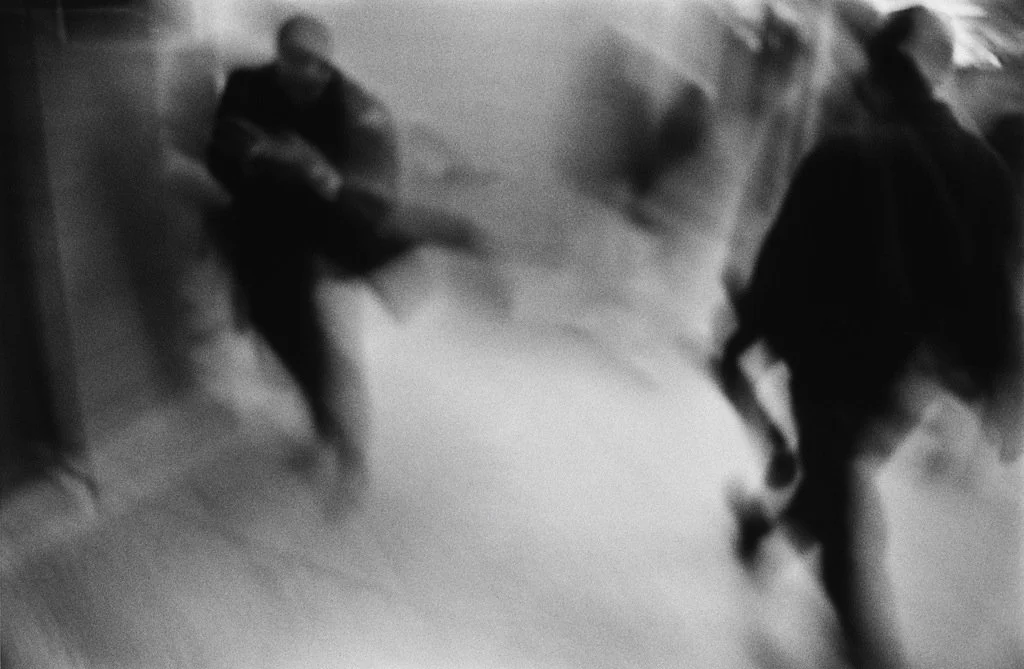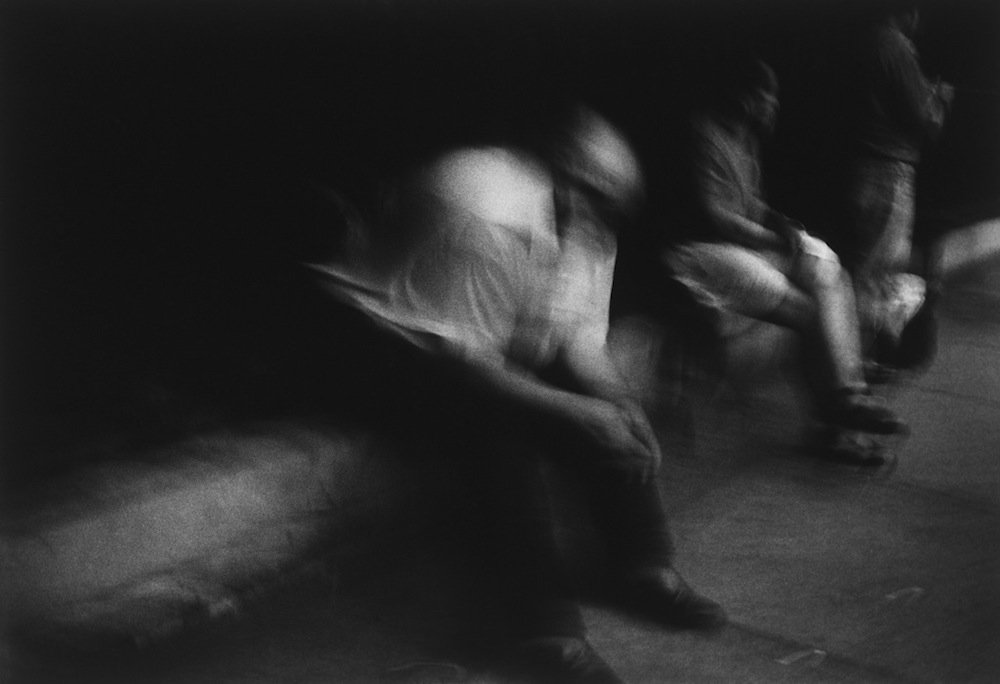Liquid City
Frank Rodick, 2017
The postmodern condition, perhaps, is that every city will begin, as far as the photograph is concerned, to look the same. Every image will be untitled: the postmodern city will not so much be a place as a condition; and to capture that condition will be the challenge for the camera.
— Graham Clarke, The Photograph: A Visual and Cultural History
More Liquid City images here.
untitled, no. 1
From the series Liquid City ©Frank Rodick, 1991
The city will not so much be a place as a condition. By the time I read those words I was well on my way to finishing the 40 images of Liquid City. But the words stuck with me—an apt description of what I seemed to be doing in those years of the 1990s. Graham Clarke’s words are part of why I never titled any of the works in Liquid City, and I owe thanks to him— an erudite man who wrote thoughtfully not only about photography but on poetry and literature also—for that as well.
Liquid City wasn’t my first photographic project, but it was the first I devoted a long period of time to. When I started I knew three things. First, I’d always been a flaneur for whom walking city streets was a quiet, private thrill. Second, I felt this need to simultaneously escape and explore what was going on inside me. And third, photography was an old familiar friend.
untitled, no. 25
From the series Liquid City ©Frank Rodick, 1992
Lou Reed sang, The city is a funny place / Something like a circus and a sewer. A circus? For sure. A sewer? Well, sometimes yes, though it’s a little clichéd. But circuses and sewers are two places with secrets and, as Bill Hunt said, a good photograph always has a secret.
untitled, no. 19
From the series Liquid City ©Frank Rodick, 1991
People have always fascinated me as much as they scared me. One time I was photographing a seedy store window—I remember this sun-blanched rubber chicken hanging up from the display wall along with a cheap set of handcuffs—when the owner, a giant who reminded me of the mythically sadistic guard in the old film Midnight Express, saw me from inside and came running out in a sweaty white dress shirt, clearly less inclined to tell me to cease and desist than to beat me to a pulp. I caught a glimpse of his rhinoceros-like charging figure just out of the corner of the viewfinder and by the time he hit the street, I—the not so intrepid artist with thankfully quick feet—was already in full flight half a block away.
untitled, no. 93
From the series Liquid City ©Frank Rodick, 1998
I’ve been told, by more people than you might think, that I’m brave. But whatever bravery I have, it’s not the physical variety. So I shot mostly from the hip—cowardly perhaps, or, if I’m being more self-kindly, a shy person’s way of doing things. Sneaky for sure. But the results were intriguing more because they removed from the equation my prejudices about what a photograph should look like. And they got that much more interesting when my teacher, Henry Gordillo, gave me what remains the best piece of advice I’ve ever received. Make more pictures, commanded Henry. Lots more. And so I did, shooting, in those analogue years at least 25 rolls a week—Tri-X pulled to 200—for years and years.
(Shooting from the hip wasn’t always successfully clandestine. One time in Hamburg, I was trying to photograph this guy and his dog who were waiting alongside me at a streetlight. He saw what I was doing, said something in German unmistakably threatening and pointed towards his dog that was, alas, a Staffordshire Terrier, all muscle and bone. I tried to placate him by, idiotically, looking at his dog and then at him, saying “Hund” with a big smile, which was, yes, moronic and motivated by the fear that he would sic the dog on me. But he took pity and crossed the street, dog in tow.)
untitled, no. 55
From the series Liquid City ©Frank Rodick, 1995
Back to shooting more pictures: I owe Henry for this because that’s when things started to get going. Weird angles, uncontrolled camera movement, slow shutter speeds, the alchemy of accident—all that aided and abetted by instincts that sharpened each week. (One of the joys of early work is that you seem to learn so much so fast.)
And I loved the gifts of public spaces—the streets and sidewalks, bus terminals, train and subway stations, the buses and trains themselves. And airports, in those carefree days before 9/11. These spaces were perpetual motion machines, anonymous and transient relay stations. Nothing was fixed—not bodies, not expressions, not identities or moods.
untitled, no. 75
From the series Liquid City ©Frank Rodick, 1998
Photography was my first fling, but cinema was my first love, and I studied the latter for a while, with serious intent. But, in a fit of self-awareness, I understood my temperament a poor fit for the collective enterprise of cinema. Wisely I’d say, I made the switch to still photography, which I’d grown up with: more suitable for solitary cats. But my passion for cinema remained—and it continues to inform my practice in one way or another. I look and think that, from the start, I was looking for images that existed as something other than a representation of a point in time. On one level, what a visual artist wants is simple: to make pictures they want to look at but can’t find. I wanted an image that somehow carried within it a flow of I-don’t-quite-know-quite-what, alongside the ambiguities and uncertainties that come with, well, everything. So yes, to go back to what Bill Hunt said, I guess I was looking for secrets.
Also I suffered from a specific kind of discontent in those days. Sometimes I call it loneliness for shorthand, but it was more complicated (it always is), something to do with the manifestations of aloneness, all of it troubling though not all of it bad. I can look at Liquid City now and it’s clear that there’s a disquiet and agitation coming from much more than what appeared in front of the lens.
untitled, no. 46
From the series Liquid City ©Frank Rodick, 1994
What I loved most about working on Liquid City were the surprises. (Actually this is what I love most about working on anything in my practice. Those artists, the ones that exist, who are planful and deliberate and actually “previsualize” are missing something.) Really, there was nothing but surprises—just better or worse ones, many more of the latter. That was another benefit of looking at everything, but never through the viewfinder. And also from waiting a long time, sometimes years even, before developing film. (Somewhere in my basement sits a box with over 200 rolls of Liquid City film, undeveloped and likely rotting away by now.)
Surprises. I looked at the lone figure in untitled, no. 1 (the first on this page), stooped and labouring his way up a stairwell (the word “Herren” behind him, from a men’s toilet somewhere in Berlin, probably the bus station), and found—I still see him there—the gravity-laden solitary man that was my father. The little girl in untitled, no. 93 (fourth from top)—she surprised, even shocked me, with those hollowed out eyes and, as Stephen Perloff once called them, “paws instead of hands,” mouth agape (that would recur over and over in my work) and head twisted back to look at… what? (I have no idea. I don’t remember the shot. I don’t remember any of them.) A man in a cardigan and blazer, his face peeling off to reveal a skull (untitled, no. 46, directly above). The elderly woman in a train station sitting on a heavy bench with scratch marks that mirror her anxious clasped hands (untitled, no. 19, third from top). And the picture showing a solitary man sitting by the sidewalk, barely folded hands on knees, an aging figure with a blurred out everyman’s face, looking at the camera I think. When I saw that—untitled, no. 123 (below)—I said: there I am, that’s me, my present, future and past. And I knew that was the last. It was time to move on from Liquid City.
untitled, no. 123
From the series Liquid City ©Frank Rodick, 1999
More Liquid City images here.








